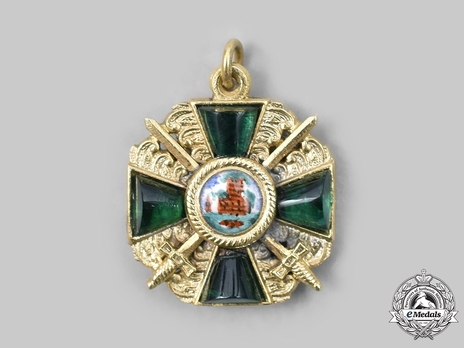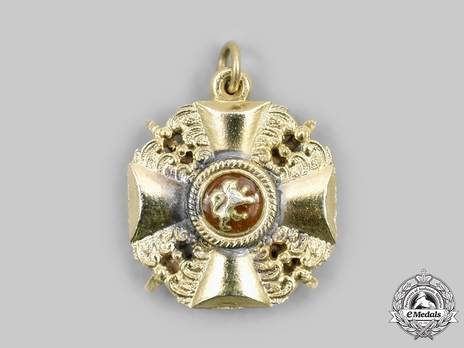Order of the Zahringer Lion, Grand Cross Miniature
CATEGORY: Miniature
SKU: 01.BAD.0103.201.01.M.000
Estimated market value:


Estimated market value:
Baden, Kingdom. An Order of the Zähringer Lion, Military Division, Miniature, c. 1900
Instituted in 1866 by Grand Duke Karl. In silver gilt, a cross pattée with convex green glass arms, two laurel leaves in each quadrant with crossed swords in between, piercing the central medallion, the obverse centre presents a hand-painted building on green foreground, the reverse arms are silver gilt, while the medallion presents a right facing rearing lion on a brown enamel field, measures 14.50mm (w) x 16.85mm (h – inclusive of integral suspension), weighs 2.9 grams, swords and leaves display great detailing, enamels intact, very fine condition.
The Order of the Zähringer Lion was established by Grand Duke Charles on December 26, 1812. It is also suggested by historians that the order was founded by Grand Duke Karl in 1809 and was named in honor of his ancestors, the Dukes of Zähringen. The Order of the Zähringer Lion was awarded to recognize civil and military merit. The first order conferral ceremonies took place in 1815. Members of the grand ducal house were born members of the order.
The order originally featured three classes: Grand Cross (and Grand Cross Breast Star), Commander and Knight. In 1815, surmounting golden oak leaves could be awarded with all classes to indicate additional merit and achievements. The oak leaves originally included an “L” cipher, but it was eventually discontinued in 1866. On June 17, 1840, the statutes of the Order were officially instituted by Grand Duke Ludwig. At that point, the Commander class was divided into I Class Commander (and I Class Commander Breast Star) and II Class Commander. In 1866, the Knight class was divided into I Class and II Class Knight. Swords were also instituted to indicate war merit. The first collar was awarded in 1868.
In 1879, the statutes were altered to permit a cross with swords to be worn beside a higher rank awarded later. Grand Duke Friedrich I also determined that Officers and war officials of the Grand Ducal Army Corps, who were bearers of the Order of Military Merit of Charles Frederick and the Order of the Zähringer Lion had to carry the latter with swords. On the occasion of Grand Duke Friedrich I’s 25 year governing jubilee in 1877, the order grew to six classes as the Knight of the Order of Berthold I was added. On April 29, 1889, a Merit Cross was added as an order grade to reward civilians for exceptional bravery and merit. The addition of the Knight of the Order of Berthold I was separated from the Order of the Zähringer Lion in its own order on September 9, 1896.
Recipients of the order could incorporate the insignia of the order into their coat of arms. If a person upgraded a class or died, the order had to be returned. The awards without swords were conferred for civil merit, while the awards with swords were conferred to recognize military merit.
The Grand Cross with Grand Cross Breast Star was, on occasion, awarded with diamonds, and there may be examples of the Grand Cross with coloured gemstones.

Comments
Sign in to comment and reply.


Scroll Top